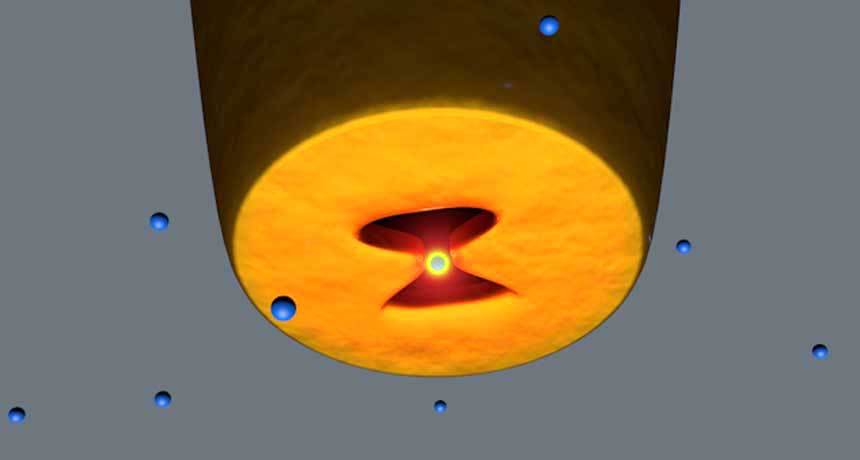Laser tweezers grab nano bits
New method uses laser light to hold and move virus-sized particles

That shiny gold dot in the middle of this drawing is a tiny plastic bead, only 50 billionths of a meter across. The image depicts how the particle is being held in place by laser light, focused by the bow tie-shaped hole. Similar laser tweezers might one day be used to hold and manipulate individual viruses, proteins and other nano-sized objects.
R. Quidant
Romain Quidant’s new tweezers are useless for pulling out splinters. But they will grab and move about plastic beads that measure just billionths of a meter across. The device that he and his coworkers built uses laser light to manipulate objects that are notoriously hard to control — such as viruses and proteins.
“You could put these particles exactly where you want them,” Phil Jones told Science News. Jones is a physicist at University College London who studies the properties of light. He did not work on the new laser tweezers.
Quidant is a physicist at the Institute of Photonic Sciences in Barcelona, Spain. He investigates the properties of light at the nanoscale. (A nanometer is one-billionth of a meter. For comparison, a human hair is about 80,000 to 100,000 nanometers thick.)
Using laser light to hold in place tiny samples isn’t new. Since the 1980s, scientists have studied molecules, bacteria and other minuscule objects under the microscope by trapping them with laser light. Lenses focus the light toward the sample. Light then gently nudges an object and holds it in place.
However, that method has its drawbacks. For one, laser light has trouble trapping things that are smaller than its own wavelength. (Light can travel as a wave, and its wavelength will be the distance from the crest of one wave to the next.) Laser light has a wavelength of between 400 and 700 nanometers. But viruses and proteins are only a few dozen nanometers across. To study things that small, scientists have turned to more energetic lasers. But they can overheat a sample, destroying it.
The tweezers Quidant and his team built gets around that problem. They now can hold a nano sample without frying it. The key was developing the proper lens.
In earlier experiments, they had observed that electrons swimming around in metals, such as gold, could act like nano-sized lenses and redirect light into tiny spaces. (Electrons are particles that carry a negative charge. They move freely across metals such as gold.) The physicists put that idea to work in their new tweezers.
To build it, they attached gold film to the end of an optical fiber. (The fiber is made up of thin, transparent threads of glass or plastic that can transmit light.) Then the researchers cut a small, bowtie shape in the gold film. When they shined laser light through the optical fiber, the bowtie-shaped hole focused the light.
To test the new device’s gripping power, they dipped it into a tank of water containing plastic beads. Each bead was no more than 50 nanometers in diameter. “The beads cannot be trapped with conventional tweezers,” Quidant told Science News. But the new tweezers successfully grabbed individual beads and held on to each for minutes at a time. Quidant’s team reported its achievement, March 2, in Nature Nanotechnology.
The scientists also attached a motor to the optical fiber. This allowed them to move the fiber slowly in different directions. That test showed that the tweezers could manipulate a tiny particle held in its grasp. And if a trapped bead began to float away, the laser light nudged it right back.
The new tool requires only about as much power as a laser pointer. That means it shouldn’t overheat tiny, delicate objects while they are being observed. That’s particularly important in biology, since too much heat could kill a living sample.
Jones says he can imagine a future when biologists could use the tool to pick up a virus, stick it on a cell and watch it attack. “It’s a very clever method,” he said.
Power Words
biology The study of living things. The scientists who study them are known as biologists.
fiber optics The use of thin, flexible fibers of glass (known as optical fibers) or other transparent solids to transmit light signals, chiefly for telecommunications.
laser A device that generates an intense beam of coherent light of a single color. Lasers are used in drilling and cutting, alignment and guidance, and in surgery.
lens (in physics) A transparent material that can either focus or spread out parallel rays of light as they pass through it.
microscope An instrument used to view objects, such as bacteria or the single cells of plants or animals, which are too small to be visible to the unaided eye.
nano A prefix indicating a billionth. It’s often used as an abbreviation to refer to objects that measure in the billionths of a meter in length or in diameter.
nanoparticle A small particle measured in the billionths of a meter.
optical fibers (see fiber optics)
particle A minute amount of something.
photonics Technology and research on the properties and transmission of light particles, called photons.
physicist A scientist who studies the nature and properties of matter and energy.
wavelength The distance between one peak and the next in a series of waves, or the distance between one trough and the next. Visible light — which, like all electromagnetic radiation, travels in waves — includes wavelengths between about 380 nanometers (violet) and about 740 nanometers (red). Radiation with wavelengths shorter than visible light includes gamma rays, X-rays and ultraviolet light. Longer-wavelength radiation includes infrared light, microwaves and radio waves.







